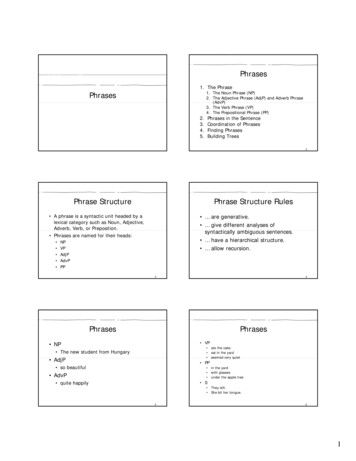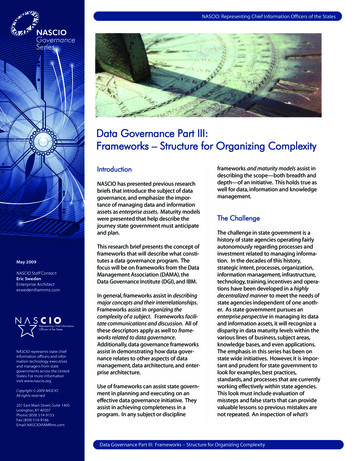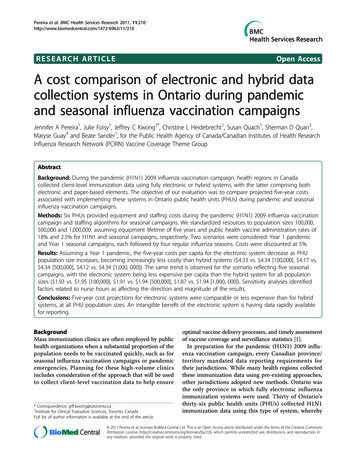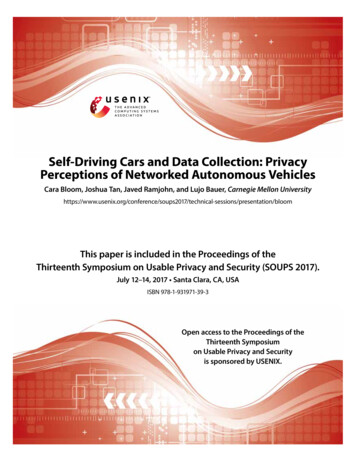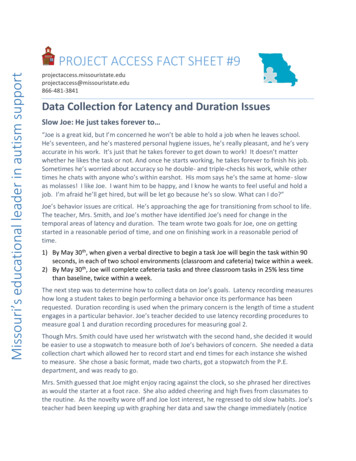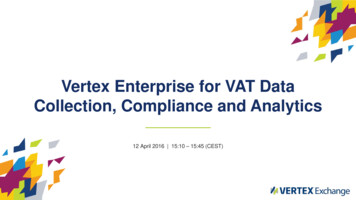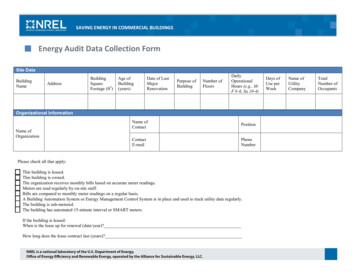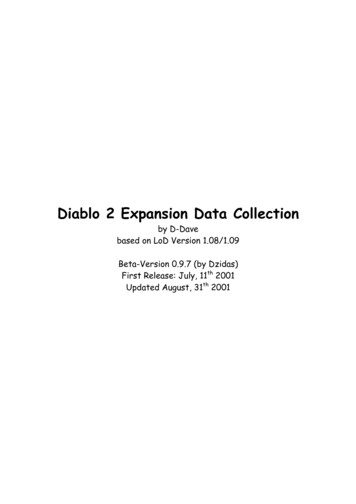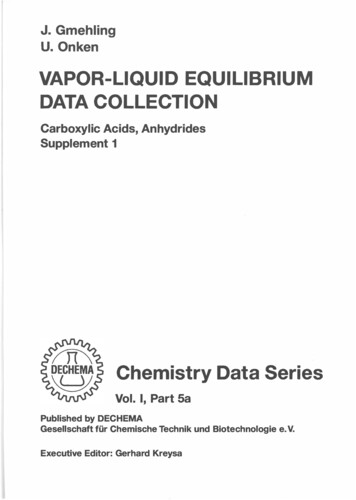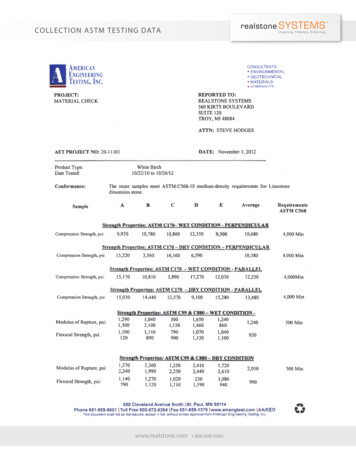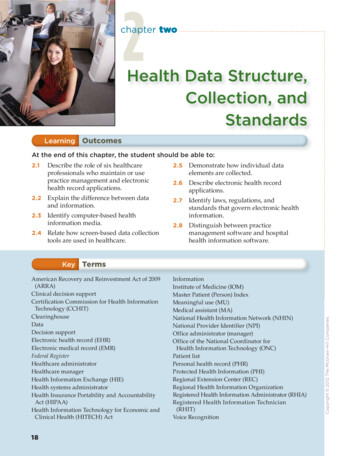
Transcription
2chapter twoHealth Data Structure,Collection, andStandardsLearning OutcomesAt the end of this chapter, the student should be able to:Describe the role of six healthcareprofessionals who maintain or usepractice management and electronichealth record applications.2.5Demonstrate how individual dataelements are collected.2.6Describe electronic health recordapplications.2.2Explain the difference between dataand information.2.72.3Identify computer-based healthinformation media.Identify laws, regulations, andstandards that govern electronic healthinformation.2.82.4Relate how screen-based data collectiontools are used in healthcare.Distinguish between practicemanagement software and hospitalhealth information software.2.1American Recovery and Reinvestment Act of 2009(ARRA)Clinical decision supportCertification Commission for Health InformationTechnology (CCHIT)ClearinghouseDataDecision supportElectronic health record (EHR)Electronic medical record (EMR)Federal RegisterHealthcare administratorHealthcare managerHealth Information Exchange (HIE)Health systems administratorHealth Insurance Portability and AccountabilityAct (HIPAA)Health Information Technology for Economic andClinical Health (HITECH) Act18InformationInstitute of Medicine (IOM)Master Patient (Person) IndexMeaningful use (MU)Medical assistant (MA)National Health Information Network (NHIN)National Provider Identifier (NPI)Office administrator (manager)Office of the National Coordinator forHealth Information Technology (ONC)Patient listPersonal health record (PHR)Protected Health Information (PHI)Regional Extension Center (REC)Regional Health Information OrganizationRegistered Health Information Administrator (RHIA)Registered Health Information Technician(RHIT)Voice RecognitionCopyright 2012 The McGraw-Hill CompaniesKey Terms
The Big PictureWhat You Need to Know and Why You Need to Know ItAs a healthcare professional you will be one of many who will be selecting, maintaining, andusing electronic health record and management software. Knowing who within the organization is using the software and how they are using it is important to selecting a system thatmeets the needs of the organization. The collection of data must be done efficiently whilemeeting the documentation requirements of licensing and accrediting agencies, as well asinsurance carriers (including Medicare), and conforming to the legal definition of an electronichealth record. We will begin this chapter by reviewing the professionals involved and the positions they may hold within the organization. Then, the concepts of data structure, collection,and standards will be introduced in preparation for a more detailed level of instruction foundin the remaining chapters of the text. We will also cover how data is collected, the tools usedto collect the data, how data is transformed into information, and the regulations and standards that dictate the collection, maintenance, use, and storage of health information in anelectronic form.Health Information Management spans a wide range of functions and processes within ahealthcare organization. Just about every decision that is made is based on statistics that arelargely collected from the health records of a facility. The data that is captured will result ininformation that is used by care providers to make decisions regarding patient care and to justify reimbursement. In addition, various levels of administrators will use information in risk management activities, budgeting, strategic planning, quality assessment, and financial reporting.Copyright 2012 The McGraw-Hill CompaniesReport writing will be discussed in greater detail in Chapter 9.Table 2.1 depicts a few of the medical professions within healthcare, the education or certifications they may hold, and the responsibilities they may have as pertains to the collection and use ofinformation. This is not an exhaustive list, as there are myriadother positions such as therapists, laboratory technicians, andradiology technicians, just to name a few. Those listed are the positions held by individuals who will most likely be involved inselecting, implementing, maintaining, and using the electronicsystems in a healthcare facility.During the selection process, it is imperative that people withknowledge of health information standards, structure, andcontent be involved. The health information professional fulfillsthis role, particularly in hospitals. In addition, administrativestaff who are responsible for the effective operation of the entireorganization, including facility- or enterprise-wide informationsystems, are key to the process as well. That is not to say that individual department managers (laboratory, nursing, radiology, etc.)do not have a say—but the administrator(s) responsible for thosedepartments may be the key players in the early stages of systemselection.CHAPTER 2 HEALTH DATA STRUCTURE, COLLECTION, AND STANDARDS19
ProfessionMedical Professions within HealthcareCertificationsDescriptionHealth Informationand Informatics Registered Health InformationAdministrator (RHIA) Registered Health InformationTechnician (RHIT) Certified Health Data Analyst (CHDA) Certified in Healthcare Privacy andSecurity (CHPS) Work in any healthcare setting, but most often in acutecare or specialty hospitals Work in healthcare-related professions such asconsultants, software trainers and installers,government agencies, insurance companies, andlaw offices Associate’s, bachelor’s and master’s degrees available Many healthcare facilities, particularly hospitals,require certificationPositions held in the following areas: Health Information Department managers Information Technology and Systems Project management Software analyst Implementation support Information system design EHR implementation and management Data analyst Documentation management Privacy/security Release of healthcare information Risk management Compliance Utilization management Quality Assessment/Assurance Cancer Registrar Medical staff coordinatorHealth InformationSpecialty Areas(HITPro )Require completion of non-degree educational programs that prepare students tosit for competency exams in: The most recent health information/informatics roles May work in any healthcare facility, inpatient oroutpatient Each competency exam is specific to a particular rolethat plays a part in meaningful use of the electronichealth record (EHR) Clinician/Practitioner ConsultantImplementation ManagerImplementation Support SpecialistPractice Workflow & InformationManagement Redesign Specialist Technical/Software Support Staff TrainerCodingprofessionals20 Certified Coding Associate (CCA) Certified Coding Specialist (CCS) Certified Coding Specialist-Physician(CCS-P) Certified Professional Coder (CPC) Certified Professional Coder-Hospital(CPC-H) Certified Interventional RadiologyCardiovascular Coder (CIRCC )http://connect.mcgraw-hill.com Work in all healthcare settings Work in healthcare-related settings such as consultingfirms, software vendors, insurance companies Certificate or associate’s degreePositions held in the following areas: Medical Coder Reimbursement specialist Insurance biller Chargemaster specialist Insurance claims specialistCopyright 2012 The McGraw-Hill CompaniesTable 2.1
Copyright 2012 The McGraw-Hill CompaniesMedical Assistants Certified Medical Assistant (CMA) Registered Medical Assistant (RMA)HealthcareAdministrators Certified Health Care Facility Manager(CHFM) Fellow of the American College ofHealthcare Executives (FACHE) American College of Medical PracticeExecutives (ACMPE) CertificationCare Providers Physicians (Doctor of Medicine [MD]),Doctor of Osteopathy (DO) Physicians’ Assistants (PA, PA-C) Certified Nurse Practitioners (CNP) Certified Registered Nurse Midwives(CRNM) Work in any healthcare setting Requires advanced education, licensure, and possiblycertification The only medical professionals who can diagnose apatient, order diagnostic testing and therapeutic (including medications) measuresNursing Registered Nurse (RN) Licensed Practical Nurse (LPN) Provide direct care to patients May also hold non-direct care positions in Utilization Management, Risk Management, Quality Assessment, andgeneral management positions within a healthcare facility Nursing Informatics Requires associate’s or bachelor’s degree at a minimum;management positions and informatics positions mayrequire a master’s degree2.1 Typically employed in physicians’ office or other outpatient setting Requires associate’s degree or certificate Perform clinical duties such as prepping patients, takingvital signs, taking medical histories, assisting physician during exams, explaining minor procedures and giving instructions based on physician’s orders, and collecting specimens Perform administrative duties such as answering phone,making appointments, registering patients, maintaininghealth records, handing correspondence, filing healthinsurance claims, scheduling outpatient services, arranging referrals, and managing the office in general May hold positions as office managers or business managers within a medical practice Work in all healthcare organizations Bachelor’s or master’s degree typically required Plan, organize, coordinate, and direct facility or department operationsPositions held with the following titles: Hospital administrator Chief Information Officer/Manager Project manager Department manager Office manager Office administratorThe Professionals Who Maintain and UseHealth InformationIn the inpatient setting, the healthcare administrator may be a chiefexecutive officer (CEO), chief operating officer (COO), chief financialofficer (CFO), or chief information officer (CIO). These individuals typically have a bachelor’s or master’s degree (preferred) in healthcareCHAPTER 2 HEALTH DATA STRUCTURE, COLLECTION, AND STANDARDS21
22http://connect.mcgraw-hill.comCopyright 2012 The McGraw-Hill Companiesadministration and are responsible for overseeing several departments(or the entire organization). Their degree is most likely in healthcareadministration, healthcare management, or health systems administration. These individuals, who may also be called a healthcare manageror health systems administrator, concentrate on the big picture—theoperation of the organization as a whole, and in regard to health information they are concerned with how an automated systems affectsindividual departments—will it meet the needs of the board of directors and administration to supply adequate, easily obtainable decisionsupport data—will the clinicians have easily accessible, fast information—is the system secure and does it meet all standards and regulations? The health systems administrator may be known as the chiefinformation officer and will typically have a great deal of knowledgeand experience related to the technical aspects of automated systems.In a hospital setting, the Director of the Health Information Department and the Chief Information Officer work closely. Each plays a keyrole in the selection of the product. Health Information Professionalshave basic clinical knowledge, technical knowledge of automated systems, and expertise in record-keeping practice, putting them in a position to lead automation of health information efforts. Depending on thelevel and content of his or her education, a health information management professional may hold the position of chief information officer.Traditionally, the data itself has been the health information manager’smain concern, and the use of the actual technology has been scope ofthe chief information officer’s domain. The staff of the health information department will need to enter, maintain, and retrieve data fromelectronic health records and may be certified by the American HealthInformation Management Association (AHIMA). Various certificationsare listed in Table 2.1, as well as other certifications for health information professional. The most recent development in health informationcareers and competencies is the recognition of competency exams inspecialty areas which are also explained in Table 2.1.In a medical office or other outpatient setting, healthcare administrators may have the same titles as are used in the inpatient setting, or theymay be called Office Manager, Office Administrator, Business Manager,and the like. These individuals are keenly aware that electronic systemscan greatly enhance the efficiency of an office, or can just as easily be anegative force that causes inefficiencies; therefore, they are at the forefront of selecting and maintaining electronic systems that meet theneeds of the practice and its practitioners. Certification of professionalsin the outpatient setting is just as important as in the inpatient setting.Healthcare professionals such as medical assistants, nurses, medical coders and billers, and other administrative professionals will beusing the software in a medical practice and will want it to be “userfriendly,” since they will be required to enter and retrieve dataquickly yet accurately. The office administrator (manager) will begathering information from the practice management and EHR systems to ensure claims are filed and paid accurately and in a timelymanner, to ensure requirements of managed care organizations aremet, and to ensure compliance with meaningful use (MU) requirements. Meaningful use will be discussed throughout this worktext.
The American Health Information Management Association(AHIMA), the American Association of Medical Assistants (AAMA),and the American Medical Technologists (AMT) are professional associations that offer certifying exams, and provide members with up-todate, relevant information about their respective fields, continuingeducation opportunities, networking opportunities, publications, andcareer assistance. The websites for each are www.ahima.org, www.aama-ntl.org, and www.americanmedtech.org, respectively.Check Your Understanding1. What roles might be held by a Healthcare Administrator?2. What does AHIMA do?3. What is the difference between a medical assistant and an officeadministrator?Copyright 2012 The McGraw-Hill Companies2.2Data versus InformationThroughout this worktext you will see the terms data and information.They are often used interchangeably, but they are not entirely the same.Look up each term in a dictionary, and you will see within the definitions that the terms are almost interchangeable or synonymous. Thinkof it this way, though—data is a single fact, such as the patient is 60 yearsold, or that the patient is female, or the patient is African American. Singlefacts come together to form information. For example, the fact thatElena Jones is allergic to penicillin is a piece of data. But, add to thatpiece of data the fact that she breaks out in hives, has difficulty breathing, and required an emergency room visit for her last allergic reactionand we have information about Elena and her allergy to penicillin. It isvitally important that each piece of data is accurate, valid, and timely toensure that the information resulting from the data is also accurate,valid, timely, and in a usable format to ensure quality medical care.Data may be unstructured or structured. Examples of unstructured data are a dictated report, a written progress note, voice files,or scanned images of original documents. In this unstructured format, it is difficult, if not impossible, to track or trend statistics, or toshare information with healthcare agencies, public health agencies,or insurance carriers. Structured data—such as standard templatesthat are used to collect the elements of the dictated report or progress note, bar codes to identify types of reports or individual files, ornumeric codes that equate to a written diagnosis or procedure—allow computers to process the data into usable information.Check Your Understanding1. Define data.2. makes up .CHAPTER 2HEALTH DATA STRUCTURE, COLLECTION, AND STANDARDS23
Computer-Based Health Information MediaPrior to there being an electronic health record system, clinicians reliedon one medium to collect and access information about patients—paper.Many pieces of paper make up the health record, and records of patientsare often several inches thick. Paper records are contained in a folder thatis filed numerically by a medical record number or alphabetically by thepatient’s last name. It is not that paper is no longer in use, but electronicmedia is gaining acceptance in the healthcare community. And in thecoming years, the electronic health record will be a requirement ratherthan a choice thanks to the Health Information Technology for Economic and Clinical Health Act (HITECH), which will be addressedlater in this chapter. Many health insurance plans are making electronicpersonal health records (PHR) available to their subscribers. A PHRcontains a person’s health history, immunization status, current and pastmedications, allergies, and instructions given by a care provider; it oftenincludes patient education materials as well. Though insurance carriersmay provide the means to keep a PHR online, this does not replace thelegal health record kept by the patient’s care provider.Electronic health records provide physicians with decisionsupport software, which is used to access current information abouta disease or condition. This technology alerts the care provider topossible medication interactions, gives treatment options based onresults of clinical trials or research, and alerts the provider that apatient may have a particular diagnosis based on the data found inhis or her electronic record. Not so long ago, physicians wereopposed to this technology, thinking it was “cookbook medicine”;this is no longer the case, since great advances in the diagnosis andtreatment of illnesses occur so quickly, making it verydifficult or impossible to keep up with the most recentstudies, findings, and recommended treatments.Thus, decision support applications within an EHRsoftware package help to keep physicians up to dateas well as improve the quality of care given to patients.Physicians can use computerized models withinthe EHR to show where a patient’s rash is located, forexample, rather than placing an “X” on a crudelydrawn picture of a patient’s back (Figures 2.1 and 2.2).The use of videos or DVDs is not new technology,although they are now used more often to educatepatients about the procedure they are about toundergo than are handouts or educational booklets.The care provider may choose to show patients avideo while they are in the office, or provide a link toa video for patients to view from their home computer.Using this type of media ensures that the informationused to educate patients is consistent.Most EHRs now provide educational materialsfor patients, and the educational materials can be speFigure 2.1 Drawing of placement of rash cific to a particular patient’s conditions, includingtreatment options, medications, etc. The educationalon patient’s back as it would haveappeared in a paper health recordmaterials may be printed out for the patient, or they24http://connect.mcgraw-hill.comCopyright 2012 The McGraw-Hill Companies2.3
Copyright 2012 The McGraw-Hill CompaniesFigure 2.2 Computer-generated drawing of placement of rash onpatient’s backcan be provided through a secure portal that the patient accessesfrom home.Physicians and administrators may want to visually presentfindings of a study or to consult with another physician and show apatient’s disease progression. This can be done through use of softwarethat has been available for years—presentation software such as Microsoft Power-Point or Open Office IMPRESS. Spreadsheets are oftenuseful in making a point as well. EHR software provides the ability tovisually chart changes in a patient’s vital signs, for example, and showtrends or statistical changes. Patient car
management software and hospital health information software. At the end of this chapter, the student should be able to: American Recovery and Reinvestment Act of 2009 . insurance claims, scheduling outpatient services,

